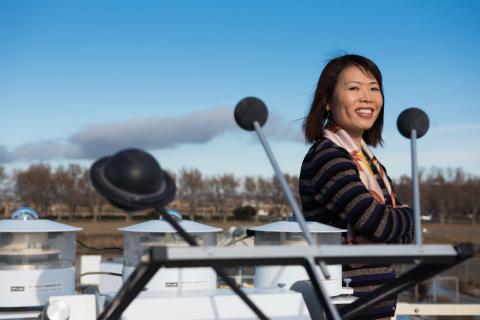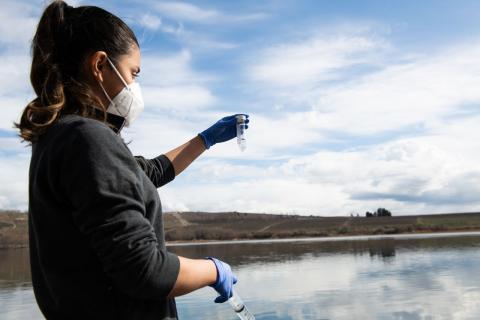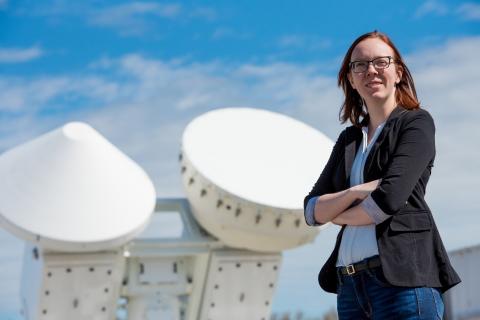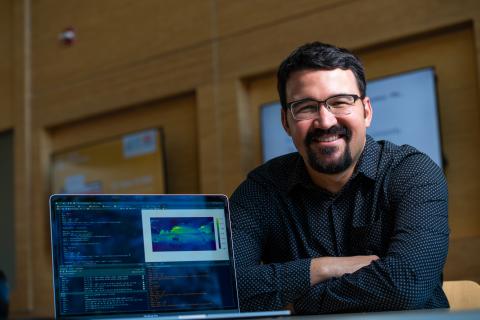Every Day is Earth Day for Some PNNL Researchers

PNNL researchers study soil samples from the Washington State University field site in Prosser to investigate microbial communities and how they are affected by drought.
(Photo by Andrea Starr | Pacific Northwest National Laboratory)
As we approach Earth Day, celebrated every year on April 22, it seems fitting to highlight the efforts of researchers at the Department of Energy’s Pacific Northwest National Laboratory who strive to surface new knowledge about our planet.
PNNL researchers take a multidisciplinary approach as they seek to understand the Earth as a complex, dynamic system. They apply their expertise in atmospheric science, ecology, hydrology and biogeochemistry to learn about the Earth and its organisms—including people—and how they interact. By studying these complexities, the researchers are improving our ability to predict the availability of natural resources, protect the environment and address the impacts of climate change.
To share a glimpse of our far-reaching research activities, I will touch on how PNNL is advancing our understanding of what happens above, below and on the Earth’s surface.
Let’s start by looking above the Earth, where research focuses on fundamental atmospheric processes. PNNL researchers study tiny particles called aerosols that influence clouds and extreme weather events. Much of PNNL’s atmospheric research centers on developing models, some that simulate phenomena on a global scale and others that focus on areas as small as a few square kilometers or even square meters in size.

These sophisticated models are improving our ability to predict changes in the Earth system. More accurate and highly resolved models also will help better inform decision-makers on various approaches to mitigate and adapt to climate change while still enabling sustainable economic growth.
Next, let’s turn our attention to below ground. PNNL’s experts in subsurface science are learning about the layers of sediment and rock beneath the surface and how they interact with rivers, including the Columbia.

Our researchers study processes such as water purification and nutrient and carbon cycling at the molecular level. They explore the role of underground communities of microbes within various biological, geological and chemical processes. Other subsurface research examines how water and contaminants move within the soil. In these projects, a PNNL-developed technology translates underground measurements into time-lapse images that allow researchers to “see” what’s happening. At the Hanford site, for example, this technology has been used to observe subsurface processes and assess remediation strategies.

Finally, PNNL researchers are investigating processes taking place on the Earth’s surface. In one major area of study, scientists are delving into the intricately connected biological, geological and chemical interactions that occur where water and land meet. These areas, known as terrestrial-aquatic zones, are important, because they are home to most of the world’s population and economic production. These sensitive regions play a critical role in agriculture and climate.
While studies of land and water abound, much about the interplay between them remains unknown. Researchers using today’s computational power and new research approaches are helping to elucidate the relationships, not only between land and water, but also among the resident flora, fauna and microbes. The role of nutrients is particularly important.

As scientists learn about the processes taking place, they also delve into how the atmosphere and climate impact them and vice versa. This new knowledge is being incorporated into Earth system models that will improve our understanding of the changing planet, as well as our ability to predict extreme weather and restore ecosystems.
With Earth Day on the horizon, I recall the song, “He’s got the whole world in His hands.” At PNNL, hundreds of scientists and engineers have a hand in understanding the whole Earth and the exceedingly complex system of what lies above, below and on its surface.
Steven Ashby, director of Pacific Northwest National Laboratory, writes this column monthly. To read previous Director's Columns, visit pnnl.gov/news and filter by Director's Columns in our Latest Stories.
Published: April 19, 2021